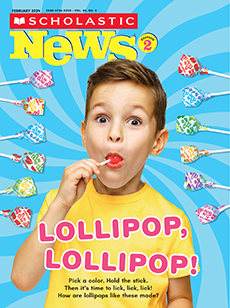Seaweed to the Rescue? Lesson Plan
Academic Standards
Reading Objective:
Children will discover how Julia Marsh is using seaweed to help Earth.
Social Studies Focus:
Earth Day
ELA Skills:
key details, vocabulary, text features, compare/contrast
Page 4 Skill:
read a chart
Vocabulary:
kelp, replace, material
CCSS:
RI.2.1 key details; RI.2.2 identify the main topic; RI.2.4 determine meanings of words; RI.2.5 use text features; RI.2.9 compare texts; RI.2.10 read informational texts; W.2.1 writing; SL.2.1 collaborative conversations; SL.2.3 ask and answer questions; L2.2. capitalization
Lexile level:
530L
Provide students with some background on Earth Day.
Build background knowledge (10 min.)
Watch our video “Earth Day Every Day.” After children have finished watching the video, discuss the following question:
- What can you do every day to care for our home?
Set a purpose for reading (5 min.)
- Pass out the issue, and discuss the cover. What do students already know about seaweed?
- Next, read the As You Read prompt on page 2: “Think about why Julia’s bags are better than plastic.” Encourage children to think about this prompt as they read.
Read together (20 min.)
Pass out the Read and Think printable. Use it to check comprehension as you read the issue together, pausing to ask the questions.
Review vocabulary (3 min.)
Next, play the online vocabulary slideshow. This issue’s featured words are kelp, replace, and material.
Assessment: Reading Quiz
Pass out the Reading Quiz to review key concepts from the issue and assess students’ proficiency on key nonfiction reading skills.
- "Throw Out That Trash!" gives children practice in capitalization. Every time children answer correctly, a piece of trash goes into the bin!
You can use our printable worksheets to focus on important ELA and science skills. Here's how.
ELA Focus: Vocabulary (15 min.)
- Use the Word Work printable to deepen students’ understanding of the words kelp, replace, and material.
Editor’s Pick: Engineering (15 min.)
- The Earth Day Problem Solvers skill sheet provides a scaffolding for a multiday project that inspires students to solve some environmental problems on their own!
ELA Focus: Text Features (15 min.)
- Students will revisit the issue and examine its features with the Text Feature Hunt skill sheet.
ELA Focus: Compare/Contrast (15 min.)
- Pair this issue with this month’s “Liam the Butterfly Helper” issue. Then have students compare Julia’s and Liam’s efforts to help Earth with the Compare the Earth Helpers skill sheet.
Here are two past issues you can use to extend your lesson on Earth Day:
- "Jellyfish or Plastic Bag?," April 2021. Students will discover ways to keep plastic bags out of the ocean.
- “Surf for the Earth,” April 2022. This issue introduces students to a man who recycles trash to make new surfboards.
You can find a higher-Lexile-level and a lower-Lexile-level version of the article online here:
- Higher Lexile level: 610L
- Lower Lexile level: 460L
